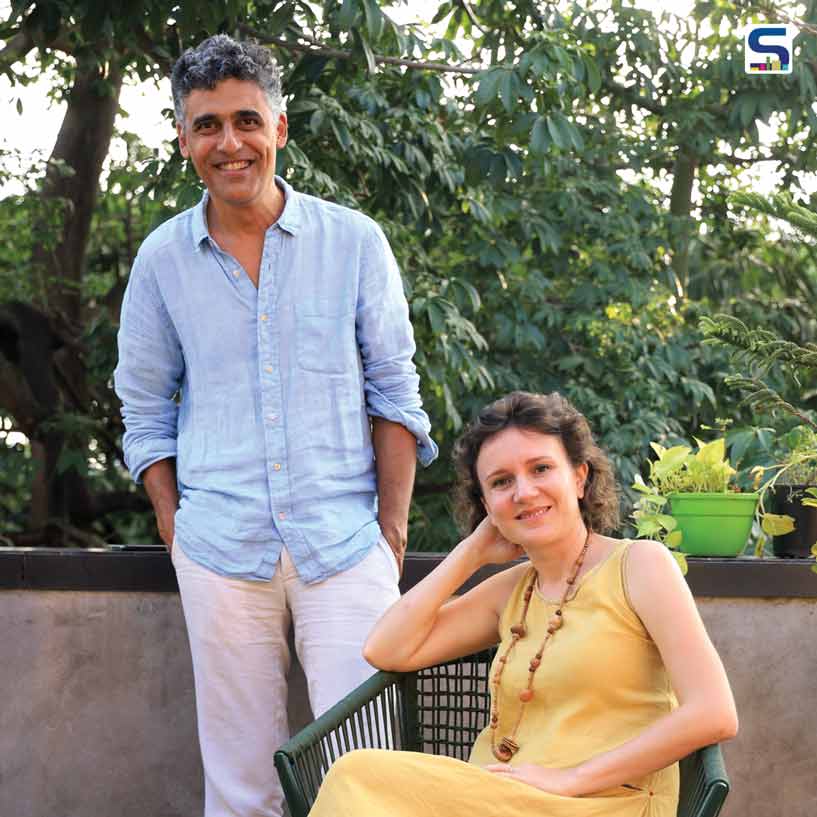
ABRAHAM JOHN ARCHITECTS is a multidisciplinary architecture, interior design, landscaping and urban planning firm founded in 1967 by notable architect Abraham John. The firm boasts a diverse portfolio of projects, ranging from private luxury villas and high-end residences to unique offices, boutique hotels and institutional buildings. In addition to its commercial work, the firm has a strong commitment to charitable causes and has contributed to the design and construction of earthquake and cyclone-proof buildings in several regions across India. Continuing the legacy, the firm is now being handled by prominent architect Alan Abraham and Anca Florescu Abraham. Alan is also a professional photographer and together they share some unique visions on Mumbai. This and more were discussed during an up and close interaction between Ar Alan Abraham, designer Anca Florescu Abraham and Verticaa Dvivedi, Founding Editor & Ms Madhurima Chowdhury, Executive Editor, SURFACES REPORTER® MAGAZINE. Here are the snippets of the conversation. To see the entire video, log onto WWW.SURFACESREPORTER.COM.
I know you’re currently both a photographer and a full-time architect, so you’re balancing both. How did it begin, and how did you come to this career choice?
I always wanted to be an artist, and I joined architecture somewhat by default. I was good at science, and at that time, we didn’t have many options. My father was an architect, so it was something I was already exposed to, and I found that I enjoyed it. I went to college, completed a couple of years, but then dropped out. Afterwards, I explored photography, travelled the world, had fun, and then came back and registered. It’s been a long journey to becoming an architect, but I’d say it’s essentially been the same path - just following my passion.
When your father was designing, did you participate or feel curious about what he was doing?
Absolutely. It was fantastic. We had typewriters and massive drawing boards, which were just amazing to me as a kid. Of course, the computer itself is very exciting in terms of what it can do, but as a physical object, it’s not quite the same. Back then, we’d sharpen pencils and use sandpaper. It was really fun and engaging.
So, you grew up around those influences. How did you and Anca meet?
It’s a long story, but we first crossed paths in France. We were both on a cultural scholarship within a group of 35 people from around the world. We immersed ourselves in French culture for about a month and a half, traveling a lot. And that’s how we met.
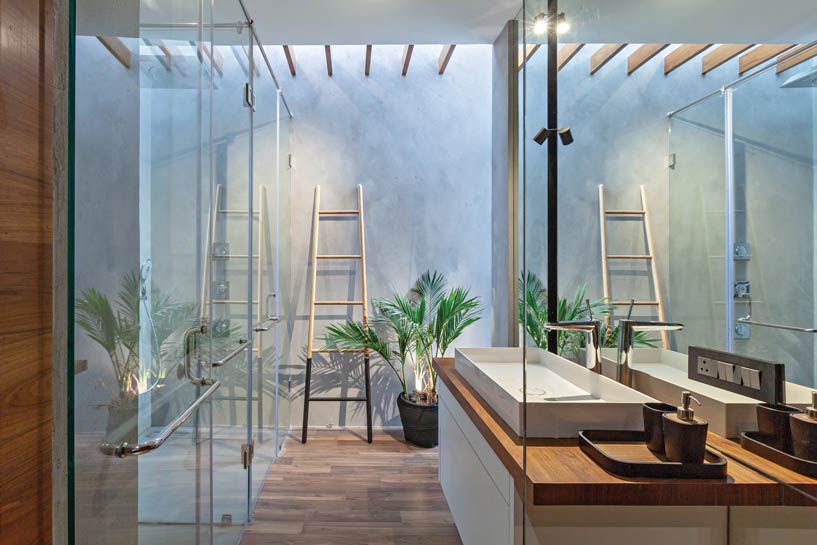
Did you get a chance to introduce each other to your cultures within the group?
Anca: Yes each country represented had an evening where they would present their customs, cusine, folk dances, and other highlights of their culture. That was actually among my first experiences of so many aspects of Indian culture. In a way, I met a photographer and married an architect.
Does it feel like you’re still exchanging and blending each other’s cultures?
Alan: She’s more Indian than we are now. She’s a Bandra Girl!
Anca: Our kids are fortunate to experience the best of both worlds. Growing up immersed in both Romanian and Indian cultures, they are exposed to such a rich and diverse blend of traditions and perspectives.
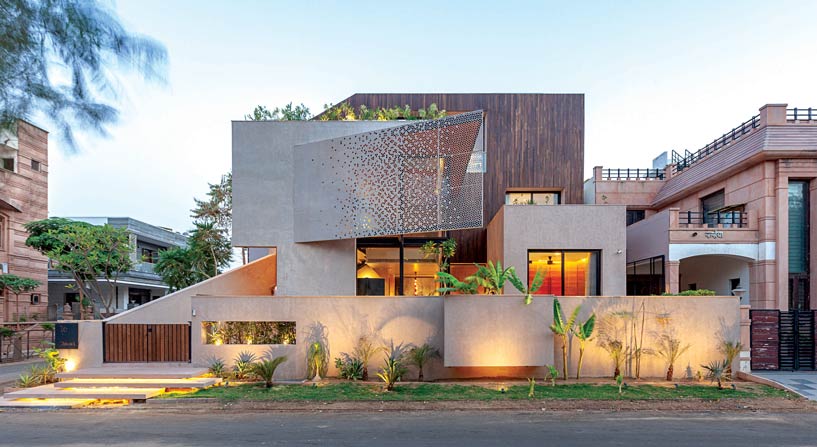
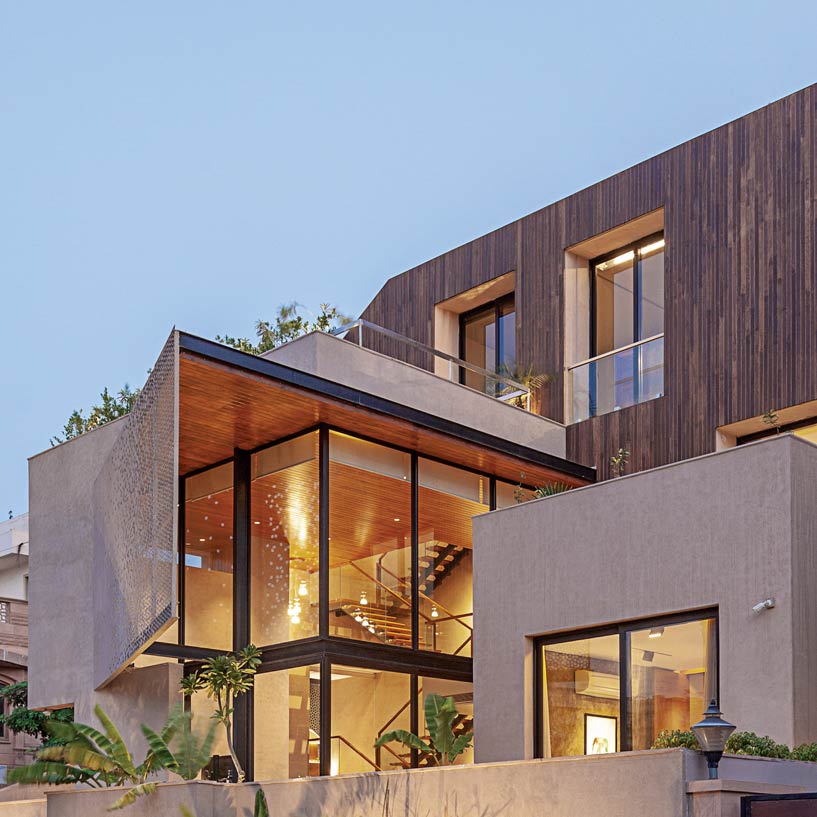
What was your first project?
My first project was a septic tank. That’s what I was assigned to work on. After that, I did a pedestal for a statue. For a while, it felt like everything I worked on was underground.
So, when did you “surface” in your career?
It took a while—several months, I think. Architecture is a slow process, especially with the types of projects we did, so it took time to establish myself.
Was there a particular lesson you learned in those early years?
I liked the slowness of the process. It felt like I was truly doing what I was meant to do. There was a real sense of scale and purpose. Each line drawn mattered, as there was no “Ctrl+Z,” “Ctrl+Y,” or cut-copy-paste. You had to be careful and thoughtful, which led to doing better work. It made me appreciate things more. Even with photography, I was working with film, so you wouldn’t get instant results—it took days. You really had to learn the craft. That was an important lesson, I feel. Today, we have the ability to learn and receive feedback instantly, which is amazing and very democratic. But I think craftsmanship has changed because technology has taken over.
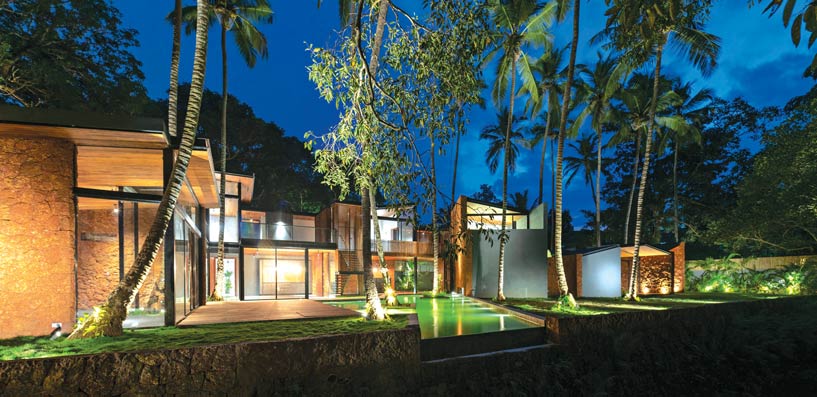
Meeting young architects and interns today, do you think they bring a lot of energy, speed, and new ideas, but perhaps miss the depth of craftsmanship?
Yes, possibly, but I also think it’s a result of the education system. Colleges could probably approach teaching in a way that instils more depth.
With your father’s background in architecture, did you ever feel that studying management would have been an added advantage to learning architecture?
Yes, definitely. We’re not particularly good at management. We have a different set of skills. We’re both more focused on the design side rather than management.
You both design a lot of high-end residential projects. Are these primarily in Mumbai or spread across India?
We work all over India, and now have projects in Switzerland and the US too. In Mumbai, we tend to do more interiors, whereas outside of Mumbai, we handle both architecture and interiors.

In Mumbai, do you get many opportunities to do this kind of landscaping, or is space an issue here?
In Mumbai, most of our projects are terrace ones, so we work on those with lots of scope for landscaping. It’s challenging, but we believe it’s very crucial for a home to have that connection to nature. We’re all part of the environment, after all. Being surrounded by plants, trees, and earth is more natural than being stuck in matchboxes. It’s not just about architecture; it’s about living life fully. Architecture plays a role in that, but it’s not everything. It’s the same in Goa. When we design something, it’s very site-contextual. It responds to the climate, the topography, the trees on site, and so forth. We don’t impose a design on a site; rather, the site imposes itself on the design. For example, if a site has a lot of trees and a particular topography, you don’t want to disturb it. Instead, you want to be a part of it and ask permission, so to speak, to be there. We design around it. That’s why, when you see our projects in Dharamshala or Ahmedabad or Goa each one looks different. We love designing around nature.
This space we’re in now feels so beautifully connected to nature. (talking about AJA Office in Bandra)
Thank you! Natural landscapes, lighting design—those are both huge parts of all our projects.
When it comes to interiors, what are the current sensibilities you address in the context of the times we’re living in?
We try to design according to people’s lifestyles. The best part of our work is meeting people with unique passions, hobbies, and personalities. We try to bring that energy into the spaces they live in. That’s the most interesting part of our job.

Mumbai is known for small spaces. Designing must be challenging, how do you manage that?
Designing for small spaces, I think we’ve learned a lot about maximizing space. Clients here usually ask for maximum storage, so we’ve become quite skilled at providing that.
What would be your top tips for maximizing space?
First, build less. If you don’t need six rooms, do four; make the rooms bigger and better. It’s essential to live your lifestyle, not someone else’s. Often, people build for others—they worry about what family or friends will think, or they try to recreate something they’ve seen in a magazine or on Instagram. But that’s someone else’s life. When clients focus on what they actually need, they end up with more space, save money, and live more comfortably. It’s important to be honest with yourself because if you build for others, you’ll eventually feel disconnected from the space.
Could you share details about some of your magnificent projects with the readers of SURFACES REPORTER®?
he first one that comes to mind is a project in Goa. It was entirely designed around 20 existing coconut trees on-site, so it was quite a challenging project, but it turned out really well - it is now a boutique hotel. Then, there’s “The Steps” in Bandra, a former narrow dilapidated public stairway at Mount Mary. We worked with the BMC to create a public living room—a kind of playroom where people can enjoy the area. We’ve activated it with festivals, and it’s very close to our hearts. It had been a dumping ground for over 30 years, with drug use and ragpickers, and it was notorious. Now, it’s been transformed into an outdoor amphitheater. It’s accessible by cycle and wheelchair, and people of all ages use it 24 hours a day. The BMC is managing it. They’re doing a good job of maintaining it.


What are the other projects you have worked on?
Another project was an apartment we designed for my brother. It’s a beautiful, sea-facing space, very minimal and clean. It is very close to our hearts. Then, we worked on a villa in Khandala called “Discovery.” It was designed around a courtyard with a pool, creating an open yet private atmosphere. It’s a journey of discovery; when you first arrive, you don’t see much. As you enter, you discover the pool, the living room, and all the connected yet private spaces. Lastly, I would say our own little flat. For personal and emotional reasons, it would make the top five. It’s very special to us.
Have you ever had clients who seemed unsure about their needs and were making decisions based on external influences? How do you handle that?
We spend a lot of time in pre-design, where we interview the client and ask them to consider various aspects. We help them understand what they truly want, so when they start building, they’re aware of every decision. Being sustainable and responsible in our work is essential, especially since building often means disturbing something. It’s about making conscious choices. Just because someone can afford it doesn’t mean they should do everything. We encourage clients to be thoughtful because each choice impacts the environment in some way. For us, the environment is everything.

How conscious are clients about sustainability and environmental impact?
They’re becoming more conscious. There’s a lot more awareness now, and many clients are more responsible than they used to be. There’s also more choice in the market for sustainable options. So, it’s hard not to be aware, and it’s definitely moving in a positive direction
Is there anything exciting in the pipeline that you’re both looking forward to????????
Yes, there are a few projects. We might be doing some buildings in Bombay, which is exciting since we don’t often get to work on larger buildings here. We’re also designing a museum in the Himalayas, which we hope will go into construction soon. We have a few nice houses and other projects lined up, including a mall we just completed in Kanpur. We’re trying to diversify our portfolio a bit, moving beyond residential projects. We also have a restaurant in New York opening in a few months, our second in the US. We’re a small team, so we try to invest our time and energy into projects in a meaningful way.
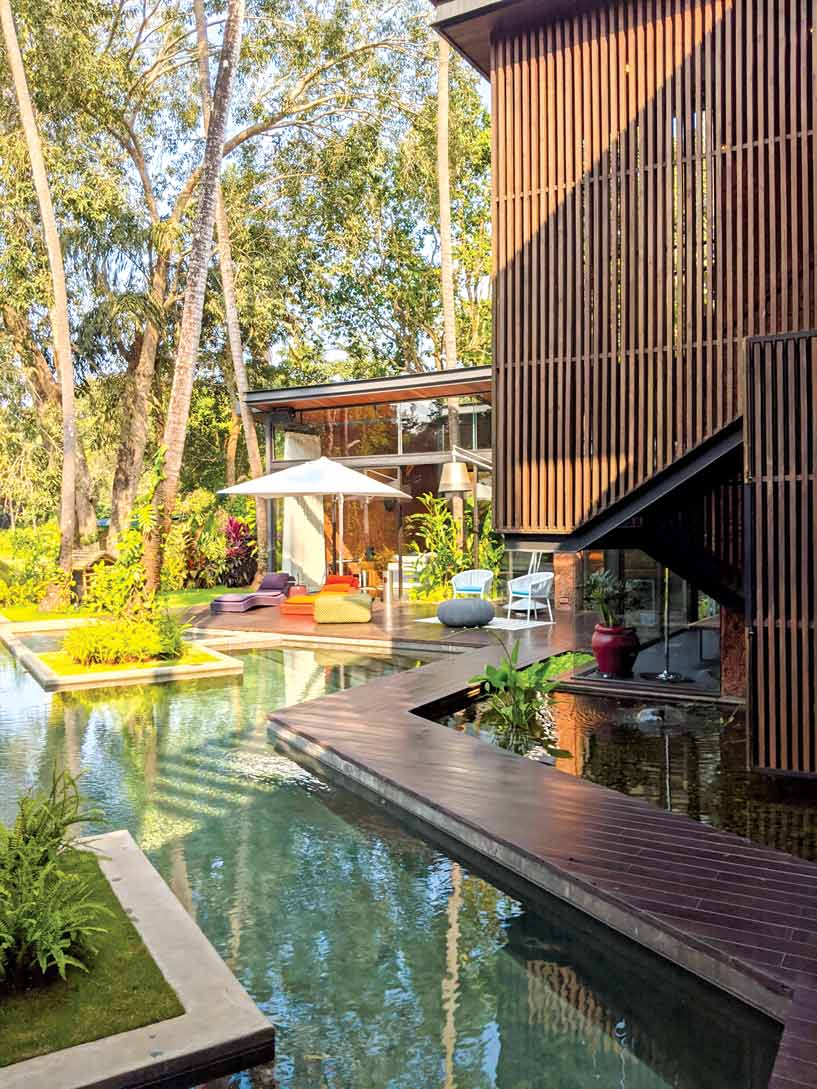

Are there any values or principles you feel you’ve picked up from your father?
Absolutely. Discipline and attitude were always priorities for him. Whatever we do, we do it well—whether it’s for a family or for many. It’s about fulfilling our responsibilities. He’s also done a lot of social work, and I think that’s influenced us to have a social impact as well. We currently have a few projects where we’re giving back to the city.
Anca, you’re such a dynamic personality. You bring so much positive energy to your work, balancing your family life with community initiatives.
I think it all started with Bombay Greenway, the urban planning arm of AJA. Alan had all these ideas about the city and improving it for our kids. One of the ideas that came to life was the St. Stephen’s Steps, also known as The Steps, Bandra. Once that project was completed, we wanted more people to visit the space, so we organized a festival. Within ten days, we pulled together a six-week festival that started with calling friends, inviting artists, and spreading the word. It began very small, but now, five years later, it has grown organically. It’s been an incredible journey, with amazing moments and so much community love.
Activating public spaces and involving people is incredible! Could you share how you started?
Sure. It all began with wanting a better city for our kids, which led to Bombay Greenway. Alan had lots of ideas, and we’d brainstorm about making proposals for the city. One of the early successes was The Steps, Bandra project, which created a public living room. After that, we felt inspired to organize the annual Festival At The Steps and invite more people to be part of it. Community support has been incredible, and seeing people of all ages use these spaces has been rewarding. We’ve had ups and downs, but the community’s energy keeps us going.

You’ve brought together so many people from the arts to activate these spaces, which isn’t easy. I sense that Alan wanted changes in the city, but you may have been the one to push him to find solutions and make them happen?
In India, there’s often a “chalta hai” (it’s okay) attitude, where people feel change isn’t possible. But we decided to take action and create solutions. That’s how we startedmaking drawings and proposals, saying, “This can definitely be improved.” It took time to convince the BMC, but we were determined, and now things are happening, slowly but surely.
So, “Bombay Greenway” was the initial initiative, but you haven’t stopped there, have you?
Bombay Greenway is essentially our office, handling the urban research and planning. Besides that, we have also founded “Love Your Parks Mumbai” to activate parks around the city. Through Bombay Greenway, we mapped all the parks in Mumbai and have plans to publish books on the subject. Later, we co-founded the “Bandra Collective” with five other architects in Bandra, working on projects like the skate park at Carter Road and other public spaces. In recent years, we also founded the “Mumbai Architects Collective,” a loose collective of established architects in the city. Our aim is to unite voices to make a stronger impact on urban planning issues.
I think that’s fantastic. Working as a collective, your group has the potential to create real change in the city.
Exactly. A collective voice is always more powerful. Architects often have clients who are influential—politicians, builders, industrialists. Through these connections, we can help educate and inspire positive change in the public realm as well.

It sounds like a really inspiring ecosystem. What message would you share with architects who wish to join the collective?
As architects, we have the power to visualize and represent. My advice is to start locally, using that power to reimagine and improve your own area. Whether it’s a street, building, or entire neighborhood, it all contributes to positive change. Self-motivation is essential, but so is collaboration. Together, we can make a real impact.
Is there a formal process to join the collective, or is it more informal?
There’s no formal process—it’s quite organic. Many of us know each other from events, juries, panels, and so on. It’s easy to recognize like-minded people, and everyone we encounter in these spaces is a potential member of the collective. I’m more of a visionary, but having people skilled in management and structure would definitely help. Even in our group, some team members are more suited to process-building. I believe that the more we tap into everyone’s strengths, the more we’ll see our city transformed.
Absolutely. It would be wonderful to have a collective effort where everyone, from different parts of society, contributes their expertise. In the end, that benefits everyone.
Yes. Ideally, you’d have a city with simple, functional buildings in a beautiful environment—like many European cities, where the design is subtle, but the setting is amazing. It’s about creating a holistic space, where the surroundings are just as important as the architecture.
What are your thoughts on public parks? Do the parks address universal accessibility?
Parks are essential because they offer universal access, unlike roads, which are often restricted to drivers of a certain age or social standing. Parks welcome everyone, from children to the elderly, giving people clean air and open space. That’s what makes a city rich. If people use parks more, they’ll stay protected. Right now, the development of public spaces feels a bit haphazard. Encroachments and plans for underground parking or municipal buildings often threaten parks and open spaces. This is why communities need to be involved, and designers and architects can lead by creating accessible, structured spaces with proper landscapes, drinking water, security, and bathrooms. We once got the BMC to agree on a standard schedule for parks to stay open from 6 a.m. to 10 p.m. Unfortunately, the pandemic disrupted that, but we want to keep advocating for accessibility.
With your dreams for the city, your accomplishments have already sparked change. It’s the beginning of a great movement.
Yes, we believe in the power of people. Initiatives like this are only possible with strong intent and commitment from everyone involved. There’s a lot of potential when people come together to make a difference.
Alan, given your big dreams for the city, if you had a magic wand, what changes would you make to Mumbai? How would you like the city to be experienced by its residents?
Mumbai is beautiful—it has the sea, hills, rivers (though polluted), lakes, and fantastic weather. But we need to connect these natural elements better and create spaces where people can enjoy them. Lifestyle and work-life balance are essential. We want a city that’s easy to move through and where people can spend time with friends in a relaxed environment. We envision design spilling out of interiors and buildings into the city, so that we all live in a positive, enjoyable environment. Clean air for our children, connected parks, and walkable spaces would be ideal.
So, in a way, what you’re doing for clients, you want to offer for everyone in the city.
Precisely. Why not? Our design sensibility should extend beyond our clients to everyone in the city. We’re ready to work for that and provide solutions wherever they’re needed. People should be able to enjoy open spaces, walk, and cycle around Mumbai—not just in South Bombay, but across the whole city. Meeting friends shouldn’t require booking a restaurant or staying indoors. Overseas, people meet outdoors; here, we’d like to see that outdoor culture develop too.
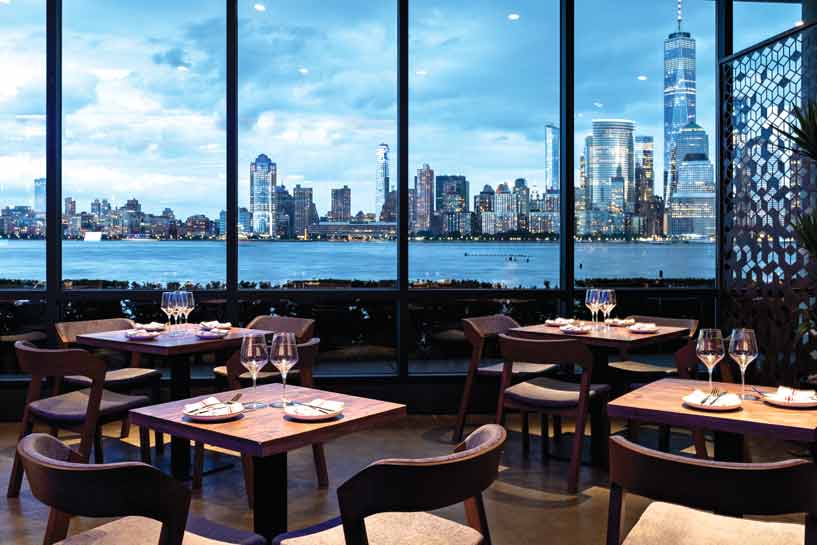
Anca, having seen Mumbai through a unique lens, if you had the same magic wand, what specific changes would you make?
First, I’d keep parks open 24/7. Before the pandemic, Love Your Parks Mumbai (@LYPMumbai) worked with the BMC and got a directive for parks to open from 6 a.m. to 10 p.m., with one park in each area to be open all night, 24/7. It was a breakthrough that unfortunately got interrupted by the pandemic, as parks were closed while malls, bars, and restaurants remained open. In a city like Mumbai, parks are essential open spaces. If I had that magic wand, I’d keep them accessible, promote alternative transportation modes, and make sure every square inch is truly used for the public. There are simple solutions that could have a massive impact. Take Juhu Aerodrome, for instance—it has over 300 acres of land that could become a public space, yet it’s still used only as a helipad. We suggested a simple 260-meter underpass connecting it to the beach, turning it into a large, accessible park. Imagine the public realm it would create. We started with Bombay Greenway, proposing to build a greenway above the railway lines, creating over 1000 acres of space from Bandra to Churchgate. People could meet friends or run the marathon along this linear park. There are so many possibilities. Design should not be exclusive; it’s for everyone.
It sounds like you’re envisioning a city built with design and community needs at its core.
Yes, design is powerful. It affects everything, from the way people experience sunlight and wind in their homes to how they live in their neighborhoods. We want that same design influence to extend to public spaces, improving people’s lifestyles across the city.
I hope that with the work you’re doing, more people join the effort and bring about the change you envision.
Yes, we see that already with our festivals and projects. It’s all about community. People come together, share their skills, and learn from each other. It’s wonderful. We’re excited to continue working toward a better city and making meaningful connections along the way.
All project photos courtesy Alan Abraham Photography @abrahamjohnarchitects | @bombaygreenway @lypmumbai | @thestepsbandra | @ancaflorescuabraham @thealanabraham.